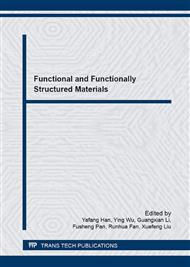[2]
H. Shirakama, E.J. Louis, A.G. MacDiarmid, et al., Synthesis of electrically conducting organic polymers: halogen derivatives of polyacetylene, (CH)x., J. Chem. Soc., Chem. Commun., 16(1977) 578-580.
DOI: 10.1039/c39770000578
Google Scholar
[3]
C.K. Chiang, M.A. Druy, S.C. Gau, et al., Synthesis of highly conducting films of derivatives of polyacetylene, (CH)x, J. Am. Chem. Soc. 100(1978) 1013-1015.
DOI: 10.1021/ja00471a081
Google Scholar
[4]
Z.Q. Zhao, X.L. Chen, The Technology Application of the Conductive and Antistatic Polymer Materials, first ed., China Textile & Apparel Press, Beijing, (2006).
Google Scholar
[5]
C.J. Yu, C. Masarapu, J.P. Rong, et al., Stretchable supercapacitors based on buckled single-walled carbon nanotube macrofilms, Adv. Mater. 47(2009) 4793-4797.
DOI: 10.1002/adma.200901775
Google Scholar
[6]
S. Nambiar, J.T. Yeow, Conductive polymer-based sensors for biomedical applications Biosens. Bioelectron. 26(2010) 1825-1832.
DOI: 10.1016/j.bios.2010.09.046
Google Scholar
[7]
S.M. Shang, W. Zeng and X.M. Tao, High stretchable MWNTs/polyurethane conductive nanocomposites, J. Mater. Chem. 21(2011) 7274-7280.
DOI: 10.1039/c1jm10255a
Google Scholar
[8]
K. T. Lau, D. Hui, The revolutionary creation of new advanced materials—carbon nanotube composites, Composites Part B 33(2002) 263-277.
DOI: 10.1016/s1359-8368(02)00012-4
Google Scholar
[9]
X. Zhi, H.B. Zhang, Y.F. Liao, et al., Electrically conductive polycarbonate/carbon nanotube composites toughened with micron-scale voids, Carbon, 82(2015) 195-204.
DOI: 10.1016/j.carbon.2014.10.062
Google Scholar
[10]
C. Feng, L.Y. Jiang, Investigation of uniaxial stretching effects on the electrical conductivity of CNT–polymer nanocomposites, J. Phys. D. Appl. Phys. 47(2014) 1-12.
DOI: 10.1088/0022-3727/47/40/405103
Google Scholar
[1]
C. Feng, L.Y. Jiang, Micromechanics modeling of bi-axial stretching effects on the electrical conductivity of CNT-polymer composites, Int. J. Appl. Electrom., 7(2015) 1-21.
DOI: 10.1142/s1758825115400050
Google Scholar
[2]
F. Gubbels, R. Jerome, E. Vanlathem,et al., Kinetic and thermodynamic control of the selective localization of carbon black at the interface of immiscible polymer blends. Chem. Mater. 10(1998) 1227-1235.
DOI: 10.1021/cm970594d
Google Scholar
[13]
A. Goldel, A. Marmur, G.R. Kasaliwal, et al., Shape-dependent localization of carbon nanotubes and carbon black in an immiscible polymer blend during melt mixing. Macromolecules 44(2011) 6094-6102.
DOI: 10.1021/ma200793a
Google Scholar
[4]
J. Chen, Study on preparation of conductive polymer blend composites through regulating the localization of carbon nanotubes, Graduate dissertation of Southwest Jiaotong university (2014).
Google Scholar
[5]
A. Thess, R. Lee, P. Nikolaev, et al., Crystalline ropes of metallic carbon nanotubes, Science. 26(1996) 483-487.
Google Scholar
[6]
X.W. Wu, J.Z. Xiao, F. Xia, et al., Dispersion methods and dispersion mechanism of carbon nanotubes, Materials Review 9(2011) 16-19.
Google Scholar
[7]
V.K. Sachdev, S. Bhattacharya, K. Patel, et al., Electrical and EMI shielding characterization of multiwalled carbon nanotube/polystyrene composites, J. Appl. Polym. Sci. 24(2014) 1-9.
DOI: 10.1002/app.40201
Google Scholar
[8]
L. Zonder, S. Mccarthy, F. Rios, et al., Viscosity ratio and interfacial tension as carbon nanotube distributing factors in melt-mixed blends of polyamide 12 and high-density polyethylene, Adv. Polym. Tech. 33(2014) 1-7.
DOI: 10.1002/adv.21427
Google Scholar
[9]
S.B. Park, M.S. Lee, M. Park, Study on lowering the percolation threshold of carbon nanotube-filled conductive polypropylene composites Carbon letters 15(2014) 117-124.
DOI: 10.5714/cl.2014.15.2.117
Google Scholar
[20]
S. Gong, Z.H. Zhua, S.A. Meguid, Anisotropic electrical conductivity of polymer composites with aligned carbon nanotubes[J]. Polymer 56(2015) 498-506.
DOI: 10.1016/j.polymer.2014.11.038
Google Scholar
[21]
B. Tian, The research progress of carbon nanotubes modified biodegradable polyester, Rubber & Plastics Resources Utilization 5(2014) 1-4.
Google Scholar
[22]
Q.F. Dong, H.B. Li, L.Y. Zhang, et al., Research on preparation and properties of PLA/PBAT/ CNTs-COOH antistatic packaging material, China printing and packing study 2(2014) 54-59.
Google Scholar
[23]
J. Alam, M. Alam, L.A. Dass, et al., Development of plasticized PLA/NH2-CNT nanocomposite: potential of NH2-CNT to improve electroactive shape memory properties, Polym. Composites 11(2014) 2129-2136.
DOI: 10.1002/pc.22875
Google Scholar


